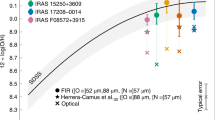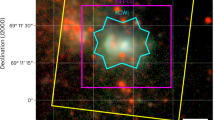Abstract
The diffuse interstellar bands are absorption lines seen towards reddened stars1. None of the molecules responsible for these bands have been conclusively identified2. Two bands at 9,632 ångströms and 9,577 ångströms were reported in 1994, and were suggested to arise from C60+ molecules (ref. 3), on the basis of the proximity of these wavelengths to the absorption bands of C60+ measured in a neon matrix4. Confirmation of this assignment requires the gas-phase spectrum of C60+. Here we report laboratory spectroscopy of C60+ in the gas phase, cooled to 5.8 kelvin. The absorption spectrum has maxima at 9,632.7 ± 0.1 ångströms and 9,577.5 ± 0.1 ångströms, and the full widths at half-maximum of these bands are 2.2 ± 0.2 ångströms and 2.5 ± 0.2 ångströms, respectively. We conclude that we have positively identified the diffuse interstellar bands at 9,632 ångströms and 9,577 ångströms as arising from C60+ in the interstellar medium.
This is a preview of subscription content, access via your institution
Access options
Subscribe to this journal
Receive 51 print issues and online access
$199.00 per year
only $3.90 per issue
Buy this article
- Purchase on Springer Link
- Instant access to full article PDF
Prices may be subject to local taxes which are calculated during checkout



Similar content being viewed by others
References
Herbig, G. H. The diffuse interstellar bands. Annu. Rev. Astron. Astrophys. 33, 19–73 (1995)
Snow, T. P. & McCall, B. J. Diffuse atomic and molecular clouds. Annu. Rev. Astron. Astrophys. 44, 367–414 (2006)
Foing, B. H. & Ehrenfreund, P. Detection of two interstellar absorption bands coincident with spectral features of C60+. Nature 369, 296–298 (1994)
Fulara, J., Jakobi, M. & Maier, J. P. Electronic and infrared spectra of C60+ and C60− in neon and argon matrices. Chem. Phys. Lett. 211, 227–234 (1993)
Kroto, H. W., Heath, J. R., O'Brian, S. C., Curl, R. F. & Smalley, R. E. C60: Buckminsterfullerene. Nature 318, 162–163 (1985)
Kroto, H. W. Space, stars, C60, and soot. Science 242, 1139–1145 (1988)
Herbig, G. H. The search for interstellar C60 . Astrophys. J. 542, 334–343 (2000)
Kroto, H. W. & Jura, M. Circumstellar and interstellar fullerenes and their analogues. Astron. Astrophys. 263, 275–280 (1992)
Cami, J., Bernard-Salas, J., Peeters, E. & Malek, S. E. Detection of C60 and C70 in a young planetary nebula. Science 329, 1180–1182 (2010)
Sellgren, K. et al. C60 in reflection nebulae. Astrophys. J. 722, L54–L57 (2010)
Chakrabarty, S. et al. A novel method to measure electronic spectra of cold molecular ions. J. Phys. Chem. Lett. 4, 4051–4054 (2013)
Gerlich, D. Ion-neutral collisions in a 22-pole trap at very low energies. Phys. Scr. T59, 256–263 (1995)
Chakrabarty, S., Rice, C. A., Mazzotti, F. J., Dietsche, R. & Maier, J. P. Electronic absorption spectrum of triacetylene cation for astronomical considerations. J. Phys. Chem. A 117, 9574–9577 (2013)
Jašík, J., Žabka, J., Roithová, J. & Gerlich, D. Infrared spectroscopy of trapped molecular dications below 4 K. Int. J. Mass Spectrom. 354–355, 204–210 (2013)
Duncan, M. A. Infrared laser spectroscopy of mass-selected carbocations. J. Phys. Chem. A 117, 11477–11491 (2012)
Bieske, E. J., Soliva, A. M., Friedmann, A. & Maier, J. P. Electronic spectra of N2+–(He)n (n = 1, 2, 3). J. Chem. Phys. 96, 28–34 (1992)
Jenniskens, P., Mulas, G., Porceddu, I. & Benvenuti, P. Diffuse interstellar bands near 9600 Å: not due to C60+ yet. Astron. Astrophys. 327, 337–341 (1997)
Foing, B. H. & Ehrenfreund, P. New evidences for interstellar C60+. Astron. Astrophys. 317, L59–L62 (1997)
Galazutdinov, G. A., Krelowski, J., Musaev, F. A., Ehrenfreund, P. & Foing, B. H. On the identification of the C60+ interstellar features. Mon. Not. R. Astron. Soc. 317, 750–758 (2000)
Edwards, S. A. & Leach, S. Simulated rotational band contours of C60 and their comparison with some of the diffuse interstellar bands. Astron. Astrophys. 272, 533–540 (1993)
Indriolo, N., Geballe, T. R., Oka, T. & McCall, B. J. H3+ in diffuse interstellar clouds: a tracer for the cosmic-ray ionization rate. Astrophys. J. 671, 1736–1747 (2007)
Maier, J. P., Lakin, N. M., Walker, G. A. H. & Bohlender, D. A. Detection of C3 in diffuse interstellar clouds. Astrophys. J. 553, 267–273 (2001)
Gasyna, Z., Andrews, L. & Schatz, P. N. Near-infrared absorption spectra of C60 radical cations and anions prepared simultaneously in solid argon. J. Phys. Chem. 96, 1525–1527 (1992)
Langford, V. S. & Williamson, B. E. Magnetic circular dichroism of C60+ and C60− radicals in argon matrixes. J. Phys. Chem. A 103, 6533–6539 (1999)
Acknowledgements
This work was financially supported by the European Research Council (ERC-AdG-ElecSpecIons: 246998)
Author information
Authors and Affiliations
Contributions
E.K.C., M.H. and D.G. recorded and analysed the experimental data. J.P.M. and E.K.C. wrote the paper with input from all authors. All authors discussed the results and commented on the manuscript. J.P.M. initiated and led the project.
Corresponding author
Ethics declarations
Competing interests
The authors declare no competing financial interests.
Extended data figures and tables
Extended Data Figure 1 Influence of laser power on the 9,577.5 Å band.
Gas-phase spectrum recorded by monitoring the depletion on the C60+–He mass channel using 1.5 mW (black) and 14 mW (red). Gaussian fits to experimental data (circles) are represented by solid lines, and give FWHMs of 2.5 ± 0.2 Å and 4.1 ± 0.2 Å at 1.5 mW and 14 mW, respectively. The blue dashed line shows a Gaussian with a FWHM of 2.5 Å.
Rights and permissions
About this article
Cite this article
Campbell, E., Holz, M., Gerlich, D. et al. Laboratory confirmation of C60+ as the carrier of two diffuse interstellar bands. Nature 523, 322–323 (2015). https://doi.org/10.1038/nature14566
Received:
Accepted:
Published:
Issue Date:
DOI: https://doi.org/10.1038/nature14566
This article is cited by
-
Quantum scattering of icosahedron fullerene C60 with noble-gas atoms
Scientific Reports (2024)
-
Single molecule infrared spectroscopy in the gas phase
Nature (2023)
-
Action spectroscopy of a single gas molecule
Nature (2023)
-
Infrared spectra of protonated and deuteronated C\(_{{60}}\) in interstellar environments
Journal of Astrophysics and Astronomy (2023)
-
Chemical synthesis and materials discovery
Nature Synthesis (2022)
Comments
By submitting a comment you agree to abide by our Terms and Community Guidelines. If you find something abusive or that does not comply with our terms or guidelines please flag it as inappropriate.



